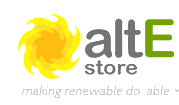Rising energy prices and electricity bills are becoming increasingly expensive and a burden on households.
The cost of electricity isn't getting any cheaper and rising every year. With the growing trend for homes and businesses relying on solar power as a reliable source of renewable energy, more people are looking for ways to save money on their electric bills without compromising their comfort levels.
Installing a grid tie inverter is an efficient and cost-effective solution that gives you the ability to reduce your electricity bills now and into the future. It will allow your home or business to automatically generate clean, non-polluting solar energy, while at the same time deducting this generated power from your own electricity meter. With lower energy costs, you'll be able to take advantage of sunnier months when there's plenty of solar radiation available and reap the rewards down the line!
Click here if you're looking for Enphase Micro Inverters. Want solar and energy storage? Click here to see our Hybrid Inverters. Need help choosing the right solar grid-tie inverter? Give us a call at 877-878-4060.
How a Grid Tie Inverter Can Save You Money on Your Electric Bill
Are you looking for a way to save money on your electric bill? Installing a grid tie inverter is an effective and easy way to do just that. A grid tie inverter is a device that ties your solar power electric system into your traditional electricity meter, allowing your generated power to automatically detract from your own electricity meter. In this blog post, we'll discuss how a grid tie inverter can save you money on your electric bill.
What is a grid tie inverter and how does it work?
A Grid-Tie Inverter is an electrical device used to convert solar power into alternating current (AC) so that it can be connected to a utility grid. It is a necessary part of any solar system, as it provides the necessary power conversion from Direct Current (DC) to AC. Grid-tie inverters are also known as solar inverters, and are the most commonly used type of inverter in solar systems.
Grid-tie inverters typically have an input voltage range which depends on the size of the solar panel array, and an output voltage which matches the utility grid voltage. Solar Grid Tie Inverters can be used in conjunction with battery-based inverters, but don't have battery capabilities inherently. They are not suitable for standalone battery storage systems, as they do not provide energy storage capabilities. Grid-tie systems are used in homes and businesses that have access to a utility grid, as they allow users to save money on their electric bill by generating their own power.
The Benefits of Using a Grid Tie Inverter
Grid-tie inverters are a popular choice for those looking to install solar panels on their property. They offer an array of benefits that make them the preferred choice when it comes to solar power systems. With a grid-tie inverter, you can convert the direct current (DC) generated by your solar panels into alternating current (AC) that is compatible with the utility grid. This allows you to easily connect your system to the grid and start generating energy for your home or business.
One of the main advantages of using a Grid-Tie Inverter is that it eliminates the need for a battery-based inverter. Off-grid inverters require batteries in order to store any surplus energy generated from your solar panels, however a Grid Tie Inverter is designed to send any extra energy directly back to the utility grid. This means that you don’t have to worry about buying and storing batteries, which makes for a much more efficient system overall.
Another benefit of Grid-Tie Inverters is that they can use transformerless inverters. These inverters provide a number of advantages including greater efficiency, lower costs, and less weight compared to traditional transformer-based inverters.
Grid Tie Solar Inverters Simplify and Reduce Costs of Going Solar
A grid tie inverter is significantly simpler and less costly than an off-grid inverter. Furthermore, a grid-tie system is simpler and less costly than an off-grid system overall.
A grid tie system essentially consists of just four major components in addition to the wiring:
By contrast, off grid inverter systems require the addition of solar charge controllers, battery bank and additional overcurrent protection and wiring.















